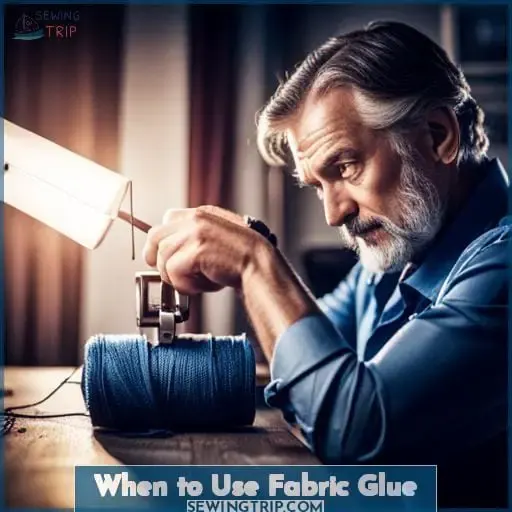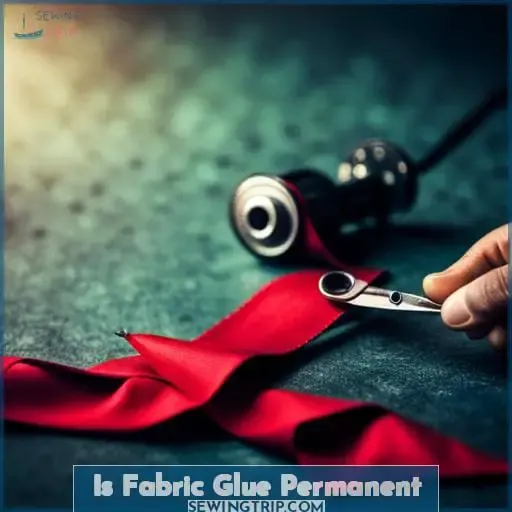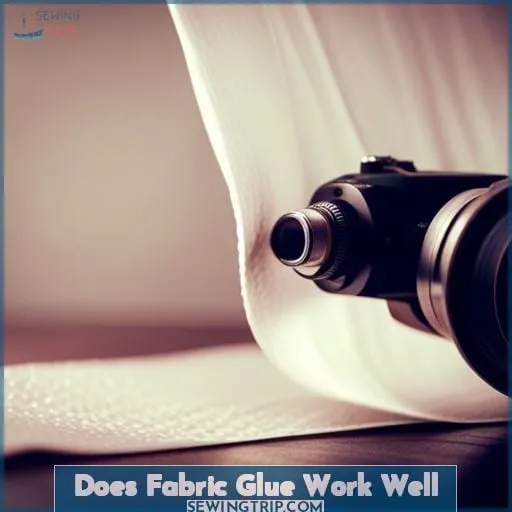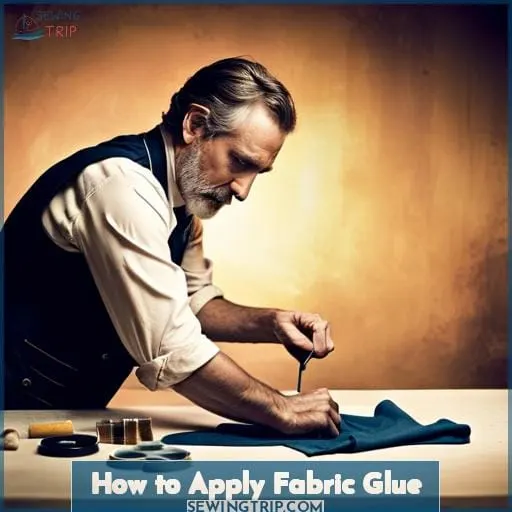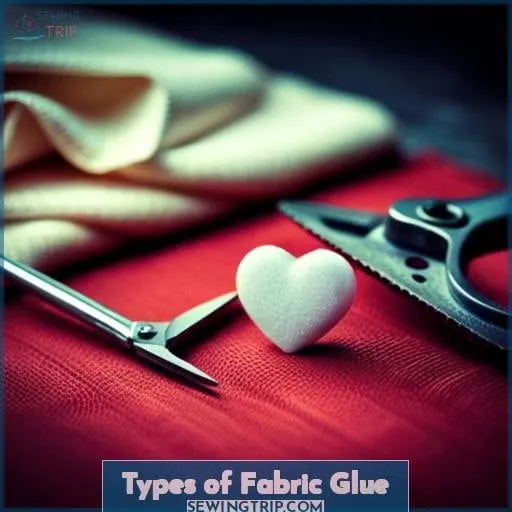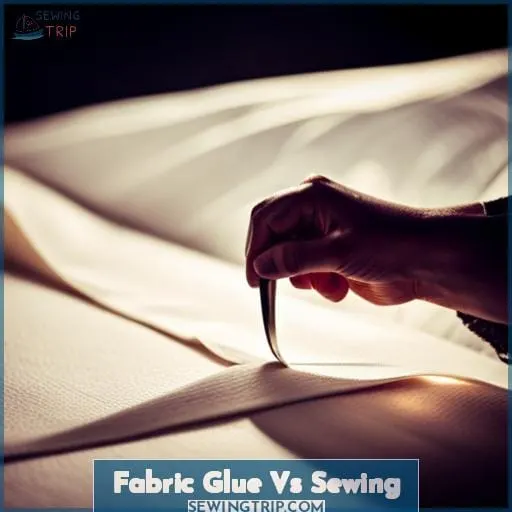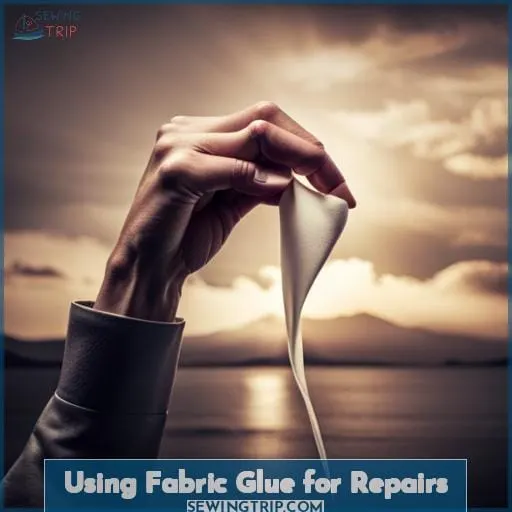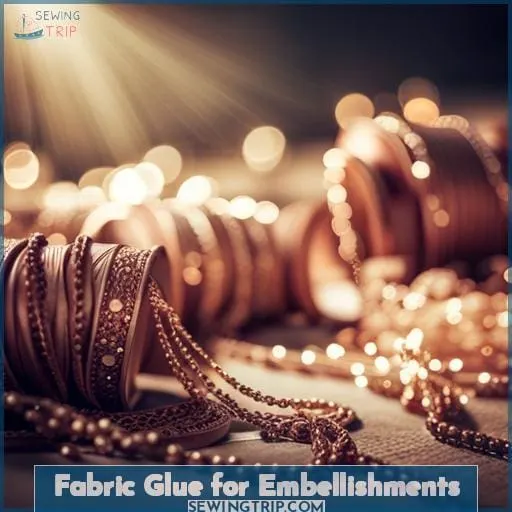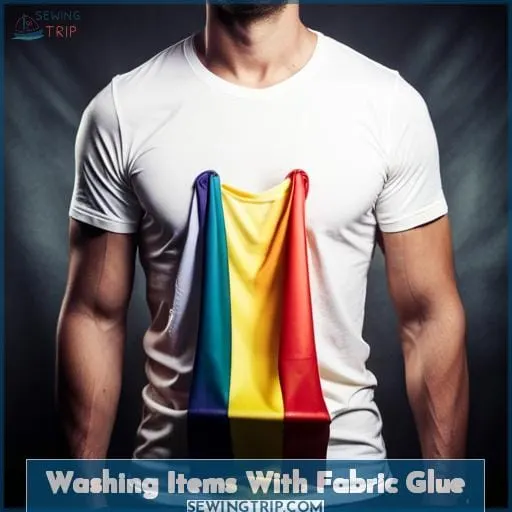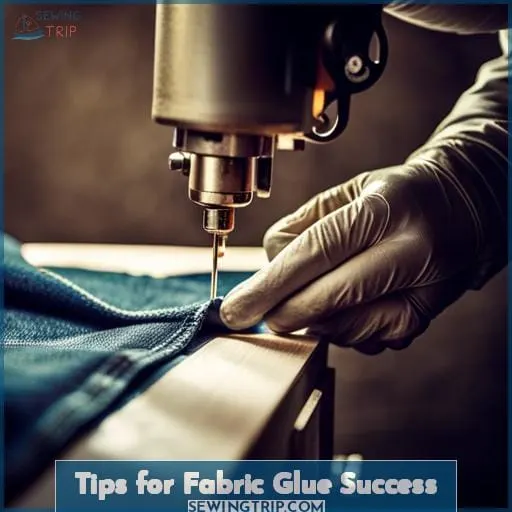This site is supported by our readers. We may earn a commission, at no cost to you, if you purchase through links.
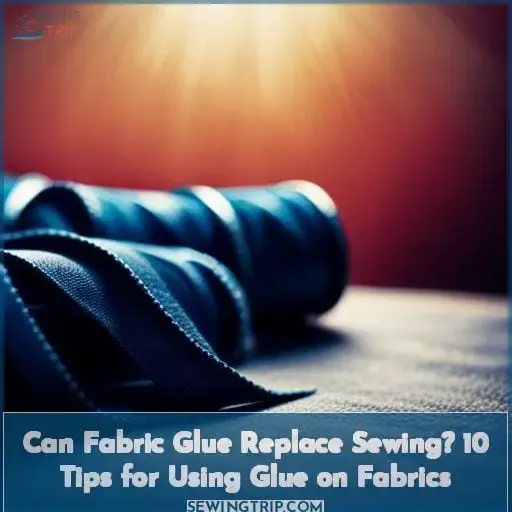 Have you ever wondered if fabric glue can spare you from sewing?
Have you ever wondered if fabric glue can spare you from sewing?
We get it, threading a needle and stitching seams takes forever. But here’s the truth: fabric glue has limits. While handy for quick fixes and embellishing, it can’t replace sturdy sewn seams. Still, used wisely, fabric glue liberates you from sewing certain elements. Follow our top ten tips to unlock the power of fabric glue without compromising quality.
- Use fabric glue for temporary projects.
- Apply glue to both surfaces.
- Press fabrics together firmly.
- Let glue dry completely before moving on.
- Use a thin layer of glue.
- Test fabric glue on a scrap piece of fabric first.
- Don’t use fabric glue on delicate fabrics.
- Use a fabric glue pen for precision.
- Apply glue to the underside of fabric for added strength.
- Use a heat press to set fabric glue.
Table Of Contents
- Key Takeaways
- When to Use Fabric Glue
- Is Fabric Glue Permanent
- Does Fabric Glue Work Well
- How to Apply Fabric Glue
- Types of Fabric Glue
- Fabric Glue Vs Sewing
- Using Fabric Glue for Repairs
- Fabric Glue for Embellishments
- Washing Items With Fabric Glue
- Tips for Fabric Glue Success
- Frequently Asked Questions (FAQs)
- Conclusion
Key Takeaways
- Fabric glue offers convenience, speed, and simplicity as an alternative to sewing.
- Fabric glue can be used on a variety of materials, including heavy-duty fabrics like denim or leather.
- Fabric glue can securely attach buttons, zippers, and other embellishments.
- Fabric glue can withstand the washing machine and can be used for permanent alterations or repairs.
When to Use Fabric Glue
When tackling quick fixes or temporary bonds, you’ll want to reach for fabric glue.
It’s ideal for creative crafting projects from costumes to decor when you need embellishments pronto.
Fabric glue simplifies emergency fixes like lost buttons or split seams when time is of essence.
It bonds most fabric types temporarily so you can decorate for seasons effortlessly, tacking up wreaths and streamers securely minus pins.
Unlike hand or machine sewing that requires technique mastery, fabric glue skips tricky steps so even total DIY novices can beautify garments and home goods successfully.
With some smart adhesive choices and application methods, fabric glue helps you:
- Ornament outfits
- Upholster furniture affordably
- Construct eye-catching DIY designs minus tedious sewing time.
Is Fabric Glue Permanent
With fabric glue, you’re working with either a permanent adhesive that withstands washing or a temporary one that washes away, depending on your project needs.
When considering whether fabric glue is permanent, there are several factors to consider:
-
Longevity comparison:
- Permanent fabric glues offer enduring bonds that can withstand multiple wash cycles without losing their adhesion.
- Temporary glues provide short-term adhesion and can be easily washed away.
- If you need to remove the glued fabrics at some point in the future, temporary glue allows for easy removal by simply washing it off.
- On the other hand, removing permanent fabric glue may require more effort and could potentially damage the fabrics.
- Some types of fabric glues have lower environmental impact than others. It’s important to choose eco-friendly options when possible to minimize harm to nature.
- Permanent fabric glues are often water-resistant or even waterproof, which means they can hold up well against moisture and weather conditions. This makes them suitable for outdoor projects or items exposed to frequent washing.
When deciding between using sewing or fabric glue for your project needs, understanding if the adhesive is permanent becomes crucial in ensuring long-lasting results while saving time and effort in hemming without sewing.
Does Fabric Glue Work Well
You’ll find fabric glue works effectively for many common applications when used properly.
Whether you’re working with delicate fabrics like felt or leather, or sturdier materials like wood and canvas, fabric glue provides a reliable adhesive solution that can save you time and effort compared to traditional sewing methods.
While hot glue may be another option for bonding fabrics together, it’s important to note that fabric glue is specifically formulated to work well on textiles without damaging them.
Fabric glue offers excellent versatility in its application. It adheres strongly to various types of fabrics without compromising their integrity. This means you can trust it for repairs on your favorite clothing items or even upholstery projects around the house.
Additionally, fabric glues are designed with durability in mind – they hold up through wash cycles so there’s no need to worry about your glued pieces coming undone after a trip through the laundry.
When using fabric glue, ensure proper application by following the manufacturer’s instructions carefully. Apply firm pressure during bonding and allow sufficient curing time before subjecting the glued item to washing or use.
Overall, if used correctly according to project requirements and material compatibility guidelines provided by manufacturers, fabric glues offer an effective alternative method that allows you freedom from conventional sewing techniques while still achieving secure bonds between fabrics.
How to Apply Fabric Glue
To properly apply fabric glue, start by cleaning the fabrics and marking designated areas for adhesive application. Cleaning the fabrics ensures that there are no dirt or debris particles that could interfere with the bonding process.
Marking the designated areas helps you have a clear visual guide on where to apply the glue.
Here are three tips for applying fabric glue effectively:
- Choose thin fabric glue: Thin fabric glues work well with delicate materials as they provide a more precise application without adding bulk. If you’re working with finer fabrics like silk or chiffon, consider thinning out regular fabric glue with acetone to achieve better results.
- Use special fabric glues: There are specialized types of fabric glues available in craft stores that cater specifically to different needs such as preventing fraying or providing extra strength bonds. These special formulas can be useful when working on specific projects that require additional support.
- Consider alternative options: While traditional liquid adhesive is commonly used for applying adhesives onto fabrics, hot glue guns can also be an effective tool when working with thicker materials or when speed is essential. Additionally, temporary glues offer flexibility and easy removal if you need to reposition your pieces before securing them permanently.
By following these tips and techniques, you’ll be able to successfully apply your chosen adhesive onto your fabrics and enjoy hassle-free sewing alternatives using just some simple steps!
Types of Fabric Glue
As we continue our discussion on fabric glue, let’s explore the different types available in the market.
When it comes to fabric glue, there are various options to choose from based on your project needs.
One common type is acid-free and heat-resistant fabric glue, which ensures that it won’t damage or discolor your fabrics when exposed to heat or over time.
Another option is spray adhesive, which provides a convenient way to apply adhesive evenly across large areas of fabric. Spray adhesives are commonly used in upholstery projects where you need a strong bond between layers of material.
For those looking for permanent solutions, there are liquid adhesives specifically designed for fabrics that offer long-lasting bonds even after washing.
If you’re working on temporary projects or need flexibility in attaching embellishments temporarily before sewing them down permanently, temporary fabric glues can be handy tools.
Overall, the choice of fabric glue depends on factors such as the nature of your project and desired permanence level required.
Fabric Glue Vs Sewing
Now that you know all about the different types of fabric glue and how to use them effectively, let’s delve into the age-old debate: Fabric Glue Vs Sewing.
As a textile engineer or sewing instructor, it’s crucial to understand when each method is appropriate and which one will give you the best results.
While sewing has long been considered the go-to method for garment construction and repair, fabric glue has emerged as a viable alternative in recent years. It offers convenience, speed, and simplicity that can be especially appealing for those who don’t have extensive sewing skills or access to a sewing machine.
Fabric glue can be used on various materials like leather shoes or hats with excellent results. It allows you to tackle crafts projects effortlessly without worrying about thread tension or needle breakage.
In terms of repairing garments with tears or loose seams, fabric glue provides quick fixes without requiring any stitching whatsoever.
Of course, there are situations where traditional sewing techniques still reign supreme – intricate designs that demand precision stitching come to mind – but for everyday repairs and simple projects; fabric glue proves its worth time and time again.
So whether you’re looking for an alternative way to mend your favorite pair of jeans quickly or add embellishments onto your crafts project without breaking out your trusty needle – consider giving fabric glue some serious consideration!
Using Fabric Glue for Repairs
If you have minor tears or rips in your fabrics, fabric glue can be a convenient and effective solution for repairs.
Simply clean the area, apply glue to both torn edges, press firmly together for 60 seconds, and allow to cure fully.
Fabric glue forms flexible bonds on materials like leather, suede, canvas, cotton, silk, even vinyl and plastic.
It works wonders for mending handbags, patching jeans, fixing hats, repairing shoes, securing carpet seams, and more in a fraction of the time sewing would require.
With some glues taking just 60 seconds to set and 5 minutes to cure, you can swiftly salvage cherished belongings on the spot sans needle and thread.
Whether you need to reattach loose soles, seam splits, broken straps, zippers, snaps, badges, buckles or buttons, fabric glue affords liberation from jerry-rigged, temporary fixes.
Harness its mighty adhesion power to effortlessly restore integrity, function and beauty to well-loved items.
Fabric Glue for Embellishments
First, let’s talk about how fabric glue can be used for embellishments.
Adding decorative touches like sequins, buttons, ribbons, or appliqués breathes new life into clothing and crafts. With some fabric glue on hand, crafters of all levels can easily secure embellishments for showstopping results.
When working on embellishment projects, temporary fabric glues allow maneuverability to perfectly position decorations before the bond sets. Once placed, the strong flexible hold keeps embellishments in place securely. Permanent fabric glues work well too when longevity is preferred over adjustability.
Fabric glues suit embellishing all sorts of materials from fabrics to leather. Specialty fabric glues for shoes, hats, and purses yield flawless customizable outcomes without stitches. Overall, fabric glues unlock creative freedom, delivering the power to Actualize imaginative embellished visions with speed and ease.
Washing Items With Fabric Glue
When washing items that have been glued with fabric glue, you should follow specific care instructions to maintain the adhesive bond and prevent damage.
- Check if the fabric glue used is permanent or temporary. Permanent fabric glues are typically water-resistant or waterproof and will hold up well to washing, while temporary fabric glues can wash away.
- Follow any care labels on the item. The manufacturer’s care guidelines should be followed to prevent the adhesive from failing or fabrics from shrinking or distorting.
- Wash gently by hand or using a delicate cycle. Harsh agitation can disturb fabric glue bonds, so gentle washing helps maintain adhesion.
- Avoid extreme water temperatures. Very hot water could soften fabric glue and cause it to fail.
For the best results when washing fabric glue projects like tote bags or kids’ crafts, permanent fabric glue paired with gentle washing allows the adhesive bond to persist through multiple wears and washes.
With some care, fabric glue can serve as a substitute for stitching in select applications.
Tips for Fabric Glue Success
To ensure success when using fabric glue, it’s important to follow these tips for optimal results:
- Clean fabrics:
Before applying fabric glue, make sure the surfaces are clean and free from any dirt or debris. This will ensure a strong bond between the adhesive and the fabric.
- Apply firm pressure:
When bonding fabrics together with glue, apply firm pressure to create a secure bond. You can use your hands or even place something heavy on top of the glued area while it dries.
- Allow curing time:
Different types of fabric glues have different curing times, so be sure to read the instructions on your specific adhesive. Giving enough time for the glue to fully cure will result in a stronger and more permanent bond.
By following these techniques and tips, you’ll be able to achieve successful outcomes when using fabric glue on various projects.
Frequently Asked Questions (FAQs)
Can fabric glue be used on all types of fabric?
You can use fabric glue on most fabrics, but test first. Some materials like silk or very sheer fabrics may be too delicate for glue.
Start with a small amount and check flexibility after drying before committing to a larger project. Going slowly helps avoid frustration down the line if the glue distorts delicate fabrics over time.
Is fabric glue suitable for heavy-duty materials like denim or leather?
Certainly! Denim and leather are indeed quite heavy fabrics. While fabric glue can provide a quick and temporary fix, for any long term use or heavy wear and tear, sewing likely remains the best option to ensure durability.
Can fabric glue be used to attach buttons or zippers?
Yes, fabric glue can securely attach buttons or zippers.
Apply a thin layer to the underside and position accurately the first try – the bond will be instant and permanent.
For strength, coat both the fabric and fastener.
Allow full cure time before use.
Will fabric glue hold up well in the washing machine?
Yes, fabric glue can withstand the washing machine, providing a secure bond that endures. Imagine confidently throwing your favorite shirt in the wash without worrying about buttons or patches coming loose.
Can fabric glue be used for permanent alterations or repairs, or is it only for temporary fixes?
Fabric glue can be used for permanent alterations or repairs, providing a strong and enduring bond.
It allows you to confidently tackle tricky sewing areas and fix hems or badges temporarily.
Liberating you from the constraints of traditional stitching methods.
Conclusion
Ultimately, while handy, fabric glue has limitations for replacing sturdy sewn seams. Used strategically in moderation, however, it can complement your sewing projects beautifully. Follow our tips to unlock fabric glue’s potential without compromising durability.
With practice, a dash of glue here and there will save you time and take your textile crafting to the next level.

